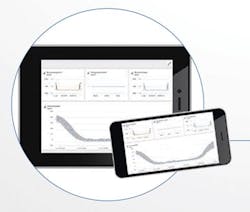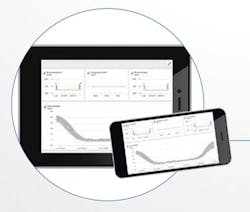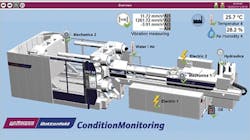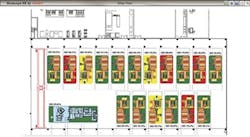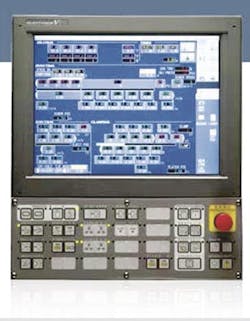Special Report: Injection machine makers tout monitoring systems
Four injection molding machine makers announced enhancements and new developments in their process-monitoring systems.
KRAUSSMAFFEI MAKES CONTROL SOFTWARE ACCESSIBLE
KraussMaffei recently introduced Data-Xplorer, a process-monitoring device that gives users easy access to the data produced by their molding machines.
"We are opening our system more and more and providing the raw data and the ability to utilize the data. This is the same information that the machine controller is using for closed-loop control of the injection molding machine, but now it is available for the customer," said Stefan Kruppa, a KraussMaffei R&D engineer.
It is another tool for processors seeking ways to validate and document their processes.
Users can identify specific types of data to use as indicators of part quality. "All injection molding processes are unique in some way, so the user may require a key point from which they can describe their process quality. The molder can view the data to select an ideal signal for monitoring," Kruppa said.
Through DataXplorer, users can access injection pressure, injection velocity, clamp force, screw position and cavity pressure, or they can inspect the action of the check ring of the non-return valve.
DataXplorer uses software from iba AG to present the machine data in a user-friendly format. No additional sensors or third-party equipment is needed for use with the device. "The data is already there. Just an interface is needed, and that is what we are doing with this introduction," Kruppa said.
DataXplorer acquires the data, records it onto a hard drive and converts it into graphs that users can easily manipulate and analyze.
The data is color-coded and users can manipulate it to create graphs focusing on a certain aspect of the process. Similar data points taken from several molding cycles can be overlaid to reveal trends.
DataXplorer lets the user export the data in a range of formats — such as Excel (CSV) — and send the information to a database or web server. The Windows-based system is an option for KraussMaffei machines with the company's MC6 control. KraussMaffei has sold several DataXplorer systems to U.S molders.
WITTMANN UNVEILS CONDITION MONITORING
Wittmann Battenfeld recently unveiled a new system that continuously monitors key components of its injection machines, with the aim of optimizing the efficiency of the machine while reducing its life-cycle costs.
The Condition Monitoring System (CMS) analyzes a comprehensive range of machine data, including measurements of vibration, screw torque, process and ambient temperatures, humidity, oil quality, screw function, data from the control cabinet, and the flow of air, oil and water.
The company's new B8 machine control captures machine data from sensors. CMS can be retrofitted to prior-generation B6 controls as well. The information goes to a central processing unit of the CMS, where it is processed and analyzed using special process-control software. Information about the machine's condition, and any proposals or decisions, based on those conditions, can be discussed by qualified personnel at the customer's plant or in collaboration with a specialist at Wittmann Battenfeld.
Users can schedule maintenance of a component based on an analysis of the machinery conditions tracked by the CMS.
At the K show, Wittmann Battenfeld demonstrated CMS on a hybrid MacroPower 1100 two-platen injection molding machine with electric injection and servo-hydraulic clamp. The molding machine produced a lightweight, automotive air-inlet component via the company's Cellmould structural foam process.
HUSKY ADDS REPORTING AND TRACKING CAPABILITIES
Husky is enhancing the tracking and reporting capabilities of its Shotscope NX web-based, process- and production-monitoring system.
Its new operator-tracking feature provides additional detail regarding the system user, said Peter Blenkiron, Shotscope NX product manager. "We have added functionality so operators of Shotscope NX now have to identify themselves before entering data into the system. Previously, the system only required the user to provide a security-level clearance to make changes," he said.
The system now maintains a record of who used the system, the time he or she logged in, the duration the operator was active and what parameters were changed. Blenkiron said the feature is in demand from medical molders seeking additional traceability in their manufacturing processes.
Husky also enhanced Shotscope NX's Data Cube function, which typically provides 10 standard report formats in Shotscope NX, from which customers create records of their process. "Previously, a customer wanting a report on other aspects of their manufacturing process required Husky to build a custom report, which cost some money and took time," Blenkiron said.
Now, Data Cube can take advantage of the wealth of data captured on Shotscope NX's database. Users can build report templates in formats of their own choosing, then pull the data off the software to populate the fields.
"Previously, a user could get a report on overall equipment effectiveness, uptime, downtime and scrap counts, but they can now access additional data. For example: Measurements of the hourly production rate and standard production rate means the user can generate a report on the number of parts expected to be made per hour, and then compare it to what they actually made in that time," Blenkiron said.
Husky has developed other functions for evaluation of parts. Until now, Shotscope NX could show how many total parts and scrap parts were made. Now, it can generate a report indicating the number of good parts.
Husky is also developing a new tracking function for various aspects of the mold. This new feature, tentatively called Complex Molds, will let the user track molding cycles and create reports for individual mold components.
"Customers want to track how many cycles have been run on a mold, and we already provide that capability, but the limitation has been when the customer reconfigures the tool," Blenkiron said.
"A mold is really made up of several components, including a hot half and cold half, runner system, inserts and cores. Those components, such as a mold insert, may be swapped out," Blenkiron said.
Husky is also working on a data-acquisition device for Shotscope NX that allows the system to be used on non-Husky equipment, Blenkiron said. Husky developed the data-acquisition device several years ago but is re-engineering it to make it simpler and cheaper.
"The device does not have to be used with Husky equipment, and does not even have to be used with an injection molding machine. It can be used to collect data from other plastics processes, including extrusion and blow molding machines," said Blenkiron. The device is currently in beta testing.
Husky also is adding networking capability to its Shotscope NX system through the incorporation of OPC-UA protocols. All data captured by Shotscope NX can be communicated to an enterprise resource planning (ERP) system, where it then performs as a data aggregator, according to Blenkiron.
TOSHIBA TARGETS REMOTE MONITORING
Toshiba is developing a new software module for use with its V50 machine controller to allow molders to monitor process conditions remotely.Initially dubbed Remote Monitoring, it provides a way to validate a process as the production cycle unfolds, said Michael Werner, senior technical key account manager, plastics machinery division.
"The remote monitoring software shows what is happening on a machine right now. The molder can see the settings of the press right now," Werner said. The user can tell if the machine is set up correctly and producing parts, he said.
Other monitoring and control solutions from Toshiba either provide a real-time look at process variables, but not from a remote location, or they show the data after the production cycle is completed.
The software, in beta testing until its release later this year, helped a molder identify a problem on a machine operating in a clean room.
"We discovered a programming bug in the software of a machine. Instead of dispatching a technician that would contaminate the clean-room environment by entering it to carry out maintenance tasks, our service department could look at the sequencing of the programming from a remote location. Working with the customer, we were able to resolve the issue, using a wireless approach to make the changes," Werner said.
When it's released, the software will have additional functionality for remote control and monitoring.
Toshiba also is developing a database for the remote monitoring software to perform what Werner calls true predictive maintenance.
The system will collect data from sensors installed on the machine to monitor vibration, torque, screw performance and other factors. The software will compile data and determine when to schedule maintenance.
Mikell Knights, senior staff reporter
For more information
Husky Injection Molding Systems Ltd.,Bolton, Ontario, 905-951-5000, www.husky.co
iba America LLC,Alpharetta, Ga., 770-886-2318, www.iba-america.com
KraussMaffei Group USA,Florence, Ky., 859-283-0200, www.kraussmaffei.com
Toshiba Machine Co. America,Elk Grove Village, Ill., 847-709-7000. www.toshiba-machine.com
Wittmann Battenfeld Inc.,Torrington, Conn., 860-496-9603, www.wittmann-group.com
